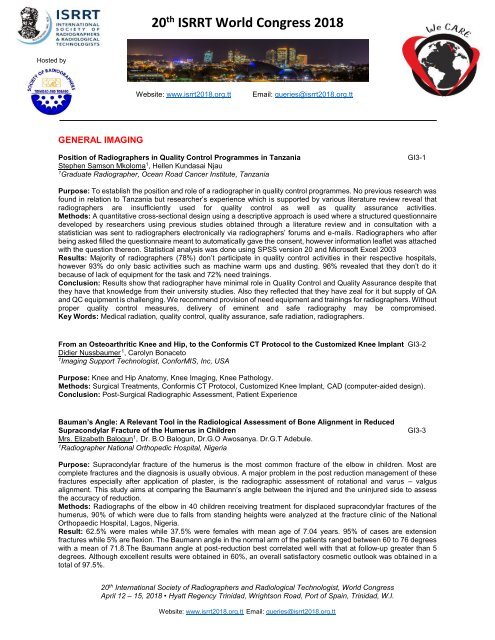Trinidad-and-Tabago-Congerss-Abstract-Book
Create successful ePaper yourself
Turn your PDF publications into a flip-book with our unique Google optimized e-Paper software.
20 th ISRRT World Congress 2018<br />
Hosted by<br />
Website: www.isrrt2018.org.tt<br />
Email: queries@isrrt2018.org.tt<br />
GENERAL IMAGING<br />
Position of Radiographers in Quality Control Programmes in Tanzania<br />
Stephen Samson Mkoloma 1 , Hellen Kundasai Njau<br />
1 Graduate Radiographer, Ocean Road Cancer Institute, Tanzania<br />
GI3-1<br />
Purpose: To establish the position <strong>and</strong> role of a radiographer in quality control programmes. No previous research was<br />
found in relation to Tanzania but researcher’s experience which is supported by various literature review reveal that<br />
radiographers are insufficiently used for quality control as well as quality assurance activities.<br />
Methods: A quantitative cross-sectional design using a descriptive approach is used where a structured questionnaire<br />
developed by researchers using previous studies obtained through a literature review <strong>and</strong> in consultation with a<br />
statistician was sent to radiographers electronically via radiographers’ forums <strong>and</strong> e-mails. Radiographers who after<br />
being asked filled the questionnaire meant to automatically gave the consent, however information leaflet was attached<br />
with the question thereon. Statistical analysis was done using SPSS version 20 <strong>and</strong> Microsoft Excel 2003<br />
Results: Majority of radiographers (78%) don’t participate in quality control activities in their respective hospitals,<br />
however 93% do only basic activities such as machine warm ups <strong>and</strong> dusting. 96% revealed that they don’t do it<br />
because of lack of equipment for the task <strong>and</strong> 72% need trainings.<br />
Conclusion: Results show that radiographer have minimal role in Quality Control <strong>and</strong> Quality Assurance despite that<br />
they have that knowledge from their university studies. Also they reflected that they have zeal for it but supply of QA<br />
<strong>and</strong> QC equipment is challenging. We recommend provision of need equipment <strong>and</strong> trainings for radiographers. Without<br />
proper quality control measures, delivery of eminent <strong>and</strong> safe radiography may be compromised.<br />
Key Words: Medical radiation, quality control, quality assurance, safe radiation, radiographers.<br />
From an Osteoarthritic Knee <strong>and</strong> Hip, to the Conformis CT Protocol to the Customized Knee Implant GI3-2<br />
Didier Nussbaumer 1 , Carolyn Bonaceto<br />
1 Imaging Support Technologist, ConforMIS, Inc, USA<br />
Purpose: Knee <strong>and</strong> Hip Anatomy, Knee Imaging, Knee Pathology.<br />
Methods: Surgical Treatments, Conformis CT Protocol, Customized Knee Implant, CAD (computer-aided design).<br />
Conclusion: Post-Surgical Radiographic Assessment, Patient Experience<br />
Bauman’s Angle: A Relevant Tool in the Radiological Assessment of Bone Alignment in Reduced<br />
Supracondylar Fracture of the Humerus in Children<br />
Mrs. Elizabeth Balogun 1 , Dr. B.O Balogun, Dr.G.O Awosanya. Dr.G.T Adebule.<br />
1 Radiographer National Orthopedic Hospital, Nigeria<br />
GI3-3<br />
Purpose: Supracondylar fracture of the humerus is the most common fracture of the elbow in children. Most are<br />
complete fractures <strong>and</strong> the diagnosis is usually obvious. A major problem in the post reduction management of these<br />
fractures especially after application of plaster, is the radiographic assessment of rotational <strong>and</strong> varus – valgus<br />
alignment. This study aims at comparing the Baumann’s angle between the injured <strong>and</strong> the uninjured side to assess<br />
the accuracy of reduction.<br />
Methods: Radiographs of the elbow in 40 children receiving treatment for displaced supracondylar fractures of the<br />
humerus, 90% of which were due to falls from st<strong>and</strong>ing heights were analyzed at the fracture clinic of the National<br />
Orthopaedic Hospital, Lagos, Nigeria.<br />
Result: 62.5% were males while 37.5% were females with mean age of 7.04 years. 95% of cases are extension<br />
fractures while 5% are flexion. The Baumann angle in the normal arm of the patients ranged between 60 to 76 degrees<br />
with a mean of 71.8.The Baumann angle at post-reduction best correlated well with that at follow-up greater than 5<br />
degrees. Although excellent results were obtained in 60%, an overall satisfactory cosmetic outlook was obtained in a<br />
total of 97.5%.<br />
20 th International Society of Radiographers <strong>and</strong> Radiological Technologist, World Congress<br />
April 12 – 15, 2018 • Hyatt Regency <strong>Trinidad</strong>, Wrightson Road, Port of Spain, <strong>Trinidad</strong>, W.I.<br />
Website: www.isrrt2018.org.tt Email: queries@isrrt2018.org.tt


















